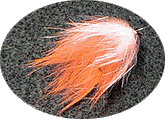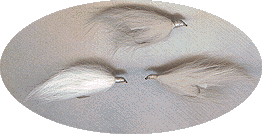As disgusting as it may seem, decaying salmon flesh is a staple for many Alaska rainbow trout, Dolly Varden and arctic char. It is pure protein and provides the vital nutrients and carbohydrates these fish need to fatten up before entering winter.
The flesh flies shown here are basically a Bunny pattern designed to resemble pieces of salmon drifting downstream. The pastel orange shades of this pattern are imitating the many bits and pieces of scraps disgarded by anglers when they clean their catch along the streambank. These "trimmings" are eagerly taken by resident trout of all sizes; the larger the pattern, the bigger the intended target. The beige and eggshell offwhite patterns resemble late season decayed flesh which has broken apart from the dead salmon carcass. Inspite of its repugnance, decaying salmon flesh is the last high protein opportunity for resident trout to bulk up before winter.
Its an easy fly to tie and the only ingredients are thread, hook and bunny fur in an assortment of colors. Hook sizes range from #6 to #2 depending on the size of fish you are targeting. .030 lead wire is often added to the hook shank to assist in sinking the presentation to proper depth.
Field Notes:
Flesh flies are most effective in late summer and fall when this food source is actually present in salmon spawning streams. Rainbow trout larger than 12 inches have entered the meat-eating stage of their life cycle and prefer flesh and salmon eggs over aquatic insects by a wide margin.
Derivations of this fly can be tied in light pastel shades of orange or red. If you are fishing a stream that has a lot of salmon angling pressure, there is sure to be a lot of fish-cleaning going on.
When anglers clean their catch, there are a LOT of bits and pieces of FRESH salmon meat tossed in the stream. These pastel shades which imitate this fresh meat are the colors you should use during that period. As the season ends and all salmon flesh in the streams decay, you should switch to the natural coloration.
Quite often fish cleaning scraps may be a combination of flesh and skin, especially from the white belly area many anglers disgard. Using a light pastel shade of orange with a white strip can be a very natural combination the trout are use to seeing. Most fly tyers overlook this combination. Use a short piece of cross cut white rabbit fur wrapped around the hook shank to create a hackle effect.
On remote streams where little if any fresh salmon scraps are in the water, the natural grays and whites will be what matches the "hatch" most naturally.
Have a selection of sizes to use. A large fish may take any size of offering whereas smaller fish may only prefer small patterns.
Fish this pattern on the bottom on a dead drift. A strike indicator on your line or leader will help determine a take. An underbody wrap of lead wire will assist in getting it down quickly if fishing deep or fast runs.





